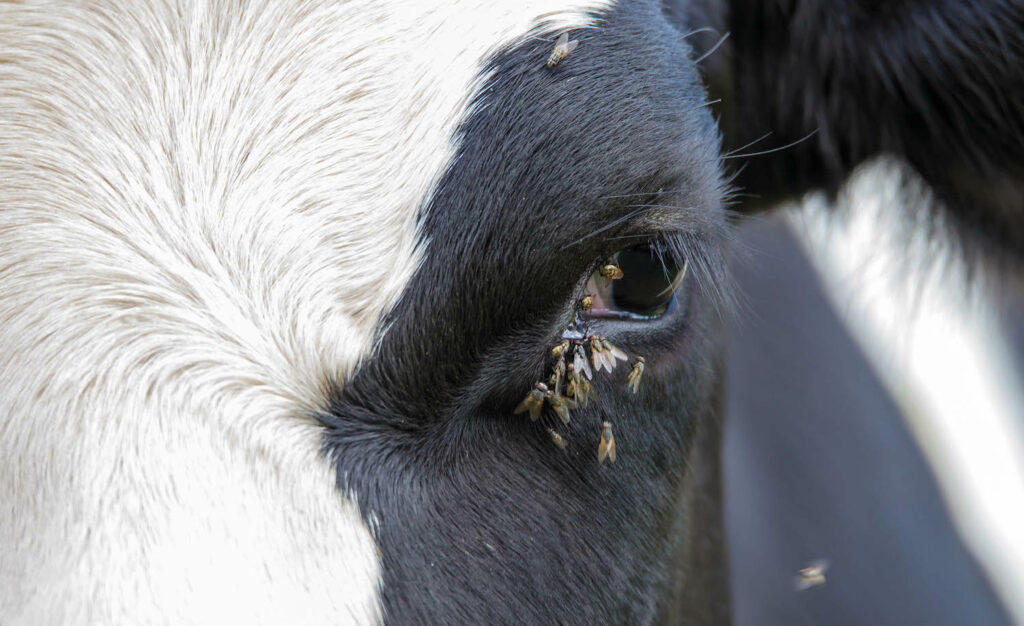A cost-effective, sustainable approach to fly control
1st April 2022
Flies can cause substantial production losses and welfare issues on livestock farms. Max Hardy, of Rutland Vets, provides guidance on prevention and management, and explores the option of biological control coupled with traditional pour ons.
The economic consequences of flies can be serious, resulting in reduced feed intakes, daily liveweight gains and milk yields. From a disease perspective, key concerns in cattle are bovine keratoconjunctivitis (New Forest eye), summer mastitis and mastitis in dry cows and heifers; while in sheep, maggots are of course a serious ongoing problem.
Since last year, Rutland Vets has been working with dairy farms to introduce biological fly control, which involves establishing a natural parasitic wasp species to kill flies before they hatch. With the drive to use medicines more sustainably, a growing number of UK veterinary practices are offering this in conjunction with traditional pour ons. As there are different predators for different substrates, a vet will need to visit the individual farm to assess the environmental conditions before picking the right biological agent to control those areas.
This is particularly suitable for farms with housed cattle as you can focus on wet areas under water troughs etc where you can actually implant the natural predators. “The aim is ultimately to get better use out of your pour ons in a more sustainable approach to prevention,” Mr Hardy said.
Set-up costs will be higher in the first year as the parasite population needs to get established, but the hope is it will then be self-perpetuating to a certain extent, though it’s likely that annual top-ups will be needed. The cost of biological control in the initial year is similar to three pour-on applications, according to costings worked out by Rutland Vets, but this should reduce over time. Overall, the cost over a year will be roughly the same with biological control as with traditional pour ons, but fly control will be improved, meaning better returns, Mr Hardy said.
When it comes to pour ons, Rutland’s drug of choice is Spotinor spot-on Solution for Cattle & Sheep. Positives of this particular product include ease of application and safety, as well as cost effectiveness. Plus, while some drugs claim to offer longer lasting effects, these require three times the volume to be applied, Mr Hardy explained. Spotinor also has a wide range of uses in the licences for cattle and sheep and can be repeated as needed for fly control.
In terms of environmental management, it’s also important to fence off water-logged areas and get muck away as quickly as possible, with good slurry and muck storage systems kept away from main animal buildings. Utilising TB testing and other opportunities when animals are being handled anyway to apply products is also helpful.
Common fly control pitfalls
Applying products too late: Waiting until fly numbers are high, especially in colder years, will “always lead to disappointment”, Mr Hardy said. All synthetic pyrethroid pour ons must be used preventatively – they are fly killers not fly repellents, he added. “The crucial thing for any fly prevention is to get in early in the fly season – at the end of April/beginning of May – to control populations by reducing the adults through the insecticide effect.
“Once you’ve got an established fly population, so many larvae will be hatching every day, no matter how much product you apply, you’ll still have a fly issue.”
Proper restraint: Treatment failures often come down to a failure to apply correctly, or early enough. Animals don’t need to be in the crush but must be well confined in a race, rather than a pen, to ensure the product is getting down the middle of the back and not running down one side. Reading operating instructions and following safety guidance are also key.
Treat all animals at the same time: It may be tempting to save money by treating only the most at-risk animals or fields, but flies will still be breeding off the untreated animals, so environmental populations will build up.
Choose the right fields to graze the highest risk cattle: “We certainly see repeated eye problems in the same fields,” Mr Hardy said. Avoid putting the most at risk into the worst fields, for example young calves will be more prone to eye issues and heifers are at higher risk of summer mastitis if autumn calving.
For more information on better fly control, speak to your vet.

